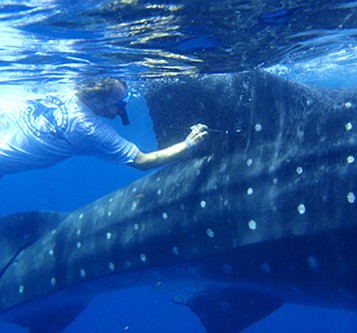- April 17, 2024
-
-
Loading

Loading

Mote Marine Laboratory’s scientists, along with collaborators from Mexico, revealed work in a nine-year study yesterday that highlights the migration of the Earth’s biggest fish — whale sharks.
Their work, published in the journal of PLOS ONE Wednesday, shows the sharks’ international journeys and their relationship to the largest whale shark-feeding hotspot known to science.
The Mote-led study shows that whale sharks found at a major feeding hotspot near Mexico’s Yucatan Peninsula travel to many places throughout the Gulf of Mexico, the northwestern Caribbean Sea and the straits of Florida.
The findings highlight why the Mexican feeding site is a vital fueling station for whale sharks throughout the region and suggests that these wide-ranging fish need international protection.
The study also documented the second-longest whale shark migration ever confirmed. It’s a trail that researchers say may help discover where the sharks give birth.
From 2003-2012, project scientists studied the whale sharks by fitting 813 sharks with ID tags and examining underwater photographs of 956 sharks to document their unique spot patterns, which serve as fingerprints and allow them to be individually identified.
Both methods allowed scientists to recognize the sharks if they were found in other areas later. The researchers also attached electronic satellite tags to 35 whale sharks — the most whale sharks ever outfitted with satellite tags in one study. They were able to track the sharks’ movements beyond the feeding site, recording the temperatures and depths of the places the animals traveled. These tags unattached from the sharks anywhere from two to 190 days later, floated to the surface and sent data to the Mote scientists via satellite.
The journal, titled “Horizontal Movements, Migration Patterns and Population Structure of Whale Sharks in the Gulf of Mexico and Northwest Caribbean Sea,” is now available online at http://dx.plos.org/10.1371/journal.pone.0071883.